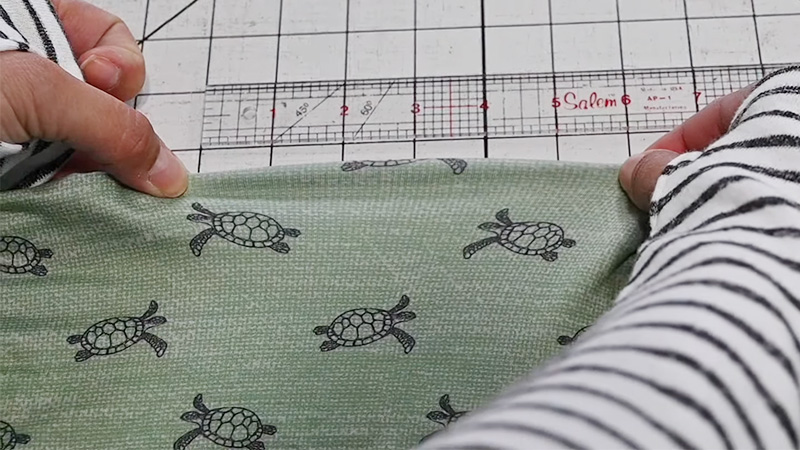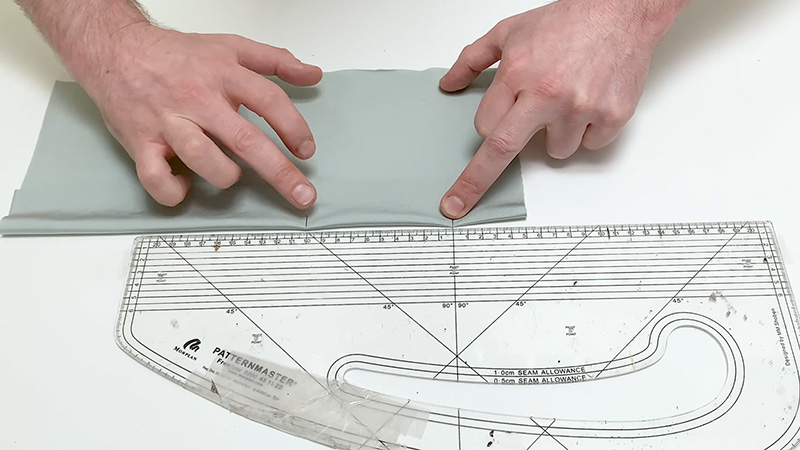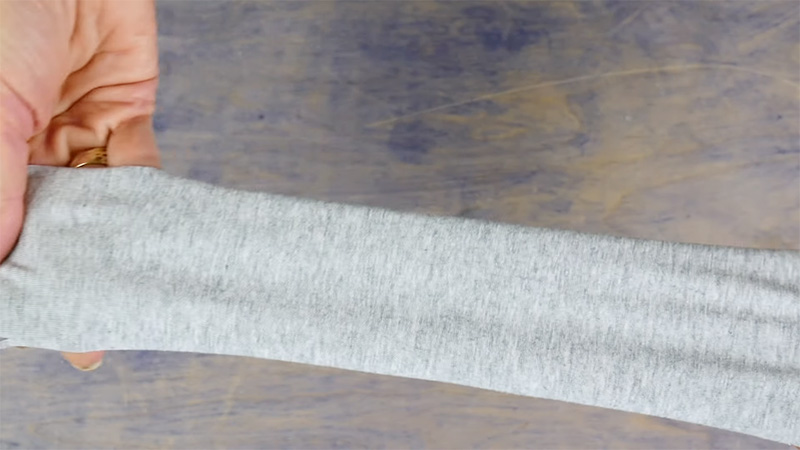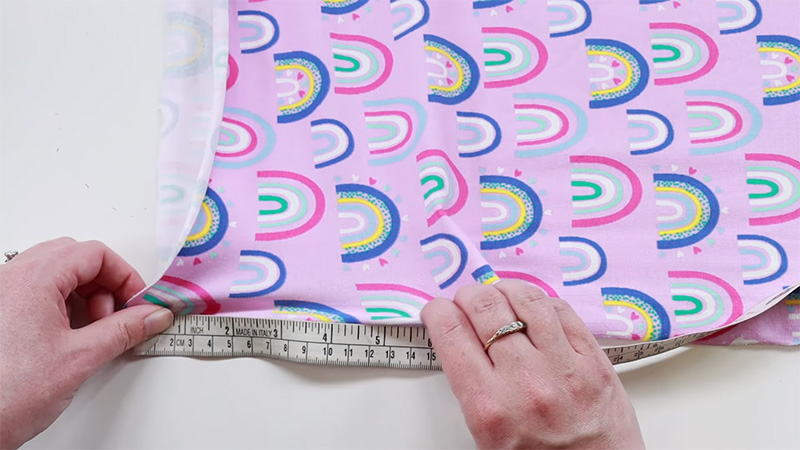Understanding the stretch factor of fabric is a crucial skill for sewists and crafters working with stretchy materials like knits and spandex. The fabric’s stretch factor plays a pivotal role in achieving the desired fit, comfort, and overall success of a sewing project.
In this comprehensive guide on “How to Determine the Stretch Factor of Fabric,” we will explore seven techniques and measurements to assess a fabric’s stretchability.
From the stretch test to percentage calculations and fabric content analysis, we will provide you with the knowledge and tools necessary to make informed fabric choices.
Whether you’re sewing garments, activewear, or crafting with stretchy materials, a solid grasp of fabric stretch will lead to more precise project planning and better-fitting creations.

How To Determine The Stretch Factor Of Fabric?
Determining the stretch factor of fabric is crucial when working with stretchy materials like knits.
Here are the techniques to help you assess the stretch factor of fabric:
Stretch Test
Hold a small piece of fabric at each end and gently pull it horizontally and vertically. Observe how much the fabric stretches. A fabric with higher stretch will stretch more.
Percentage Stretch Measurement
Measure the fabric’s original length and then stretch it gently. Calculate the percentage increase in length. A higher percentage indicates greater stretch.
Stitching Test
Sew a sample seam using the fabric and your intended stitching method (e.g., straight stitch or zigzag). Stretch the seam and check for stitch distortion or breakage. Minimal distortion indicates good stretch recovery.
Gauge Measurement
Use a stretch gauge ruler designed for fabrics. Measure the fabric’s stretch in both directions. The higher the measurement, the more stretch the fabric has.
Fabric Content Analysis
Review the fabric’s composition label. Fabrics with elastane (Spandex/Lycra) have inherent stretch, while natural fibers like cotton have limited stretch.
Fabric Manufacturer Data
Research the fabric manufacturer’s specifications or consult their website for information on the stretch factor, stretch percentage, and recommended uses for the fabric.
Hands-On Experience
Develop a tactile sense of stretch by handling various fabrics regularly. With experience, you’ll become better at gauging a fabric’s stretch by touch.
Understanding a fabric’s stretch factor is vital for selecting the appropriate fabric for your sewing project and ensuring a good fit.
It also helps you choose the right sewing techniques and settings, such as stitch type, needle, and tension, for working with stretchy materials.
How Do You Calculate The Stretch Factor In Fabric?

Calculating the stretch factor in fabric involves measuring and assessing the fabric’s ability to stretch and recover.
Here are the measurements and calculations to determine the stretch factor:
Unstretched Length
Measure a sample piece of fabric’s length in its relaxed, unstretched state. This is the starting point for calculating stretch. Also, this is a very important part.
Stretched Length
Gently stretch the fabric horizontally or vertically while measuring its length. Record the stretched length, ensuring not to overstretch the fabric.
Stretch Percentage
Calculate the percentage of stretch by dividing the difference between the stretched and unstretched lengths by the unstretched length. Multiply by 100 to express it as a percentage.
Stretch Percentage = [(Stretched Length – Unstretched Length) / Unstretched Length] × 100
Stretch and Recovery Test
Perform a stretch and recovery test by stretching the fabric to its limit and then measuring how much it recoils when released. This test assesses the fabric’s elasticity and ability to return to its original shape.
Resistance Test
Use a force gauge to measure the amount of force required to stretch the fabric to a specific length. This test provides data on the fabric’s resistance to stretching.
Elongation at Break
This measurement determines the point at which the fabric breaks when stretched. It’s often used in quality control for textiles and can indicate the fabric’s durability.
Weighted Stretch Test
Attach a weight to a fabric sample, then measure the length of the fabric with the weight applied. This test helps assess how the fabric behaves under tension.
These measurements and calculations collectively provide a comprehensive understanding of a fabric’s stretch factor.
They are essential for selecting the right fabric for sewing projects that require stretch, such as activewear, lingerie, or fitted garments, as well as for ensuring proper fit and comfort in the finished product.
How To Use The Stretch Factor Of Fabric?

Utilizing the stretch factor of fabric is essential for creating well-fitting and comfortable garments and projects.
Here are the simple methods on how to use the stretch factor of fabric:
Pattern Selection
Choose sewing patterns specifically designed for stretch fabrics if your fabric has a significant stretch factor. These patterns are tailored to accommodate the fabric’s elasticity, ensuring a proper fit.
Ease and Sizing
When cutting pattern pieces, consider incorporating ease for comfortable wear. For closely fitted garments, use negative ease, where the garment measures smaller than the body, taking advantage of the fabric’s stretch.
Seam Type and Stitching
Opt for stretch-friendly stitches like zigzag or stretch stitches when sewing stretch fabrics. These stitches allow the fabric to stretch without breaking the stitches, ensuring durability and flexibility.
Stay Tape and Stabilizers
Use stay tape or stabilizers along seam allowances or hems, especially on lightweight or highly stretchy fabrics. This helps maintain the fabric’s shape and prevents distortion.
Directional Stretch Consideration
Be mindful of the fabric’s directional stretch. Align pattern pieces and seams according to the direction of greatest stretch for better fit and comfort.
Test Garment
Create a test or muslin garment before cutting into your final fabric. This allows you to assess the stretch factor’s impact on the fit and make necessary adjustments.
Tailored Design
Take advantage of stretch fabric’s flexibility to create tailored designs with body-hugging silhouettes, ruching, gathers, or pleats that enhance the garment’s shape and comfort.
Understanding and effectively using the stretch factor of fabric is crucial for achieving professional-looking results in stretchy garments and projects.
By employing these methods, you can harness the fabric’s elasticity to your advantage, ensuring a comfortable and flattering fit in your finished creations.
How To Check If Your Fabric Has Enough Stretch?

Checking if your fabric has enough stretch is essential for ensuring a successful sewing project, especially when working with stretchy materials like knits.
Here are the tips on how to determine if your fabric has sufficient stretch:
Fabric Label
Start by checking the fabric label or description. Many fabrics, especially those with a significant stretch factor, are labeled as “stretch,” “knit,” or contain terms like “spandex” or “Lycra.” These indicators suggest the fabric has inherent stretch.
Stretch Test
Perform a simple stretch test by gently pulling the fabric horizontally and vertically. A fabric with enough stretch will expand when pulled and then return to its original shape when released. Ensure it stretches comfortably and doesn’t feel restrictive.
Stretch Gauge
Use a stretch gauge or ruler designed for measuring fabric stretch. Place the gauge on the fabric, and the measurements will indicate the fabric’s stretch percentage. Compare it to your project’s requirements.
Fabric Handling
Pay attention to the fabric’s hand or feel. Fabrics with good stretch often have a soft, supple feel and are pliable when handled. Stiffer fabrics are less likely to have sufficient stretch.
Recovery
Stretch the fabric slightly and observe how it recovers. If it bounces back and regains its original shape, it likely has good stretch and recovery properties.
Pattern Recommendation
Refer to your sewing pattern’s fabric recommendations. Patterns designed for stretch fabrics will specify the required stretch factor. Ensure your fabric meets or exceeds these requirements.
Stretch Sample
Cut a small sample of the fabric and perform a stretch and recovery test. This involves stretching the sample and observing how it behaves. If it stretches adequately and returns to its original state, it’s suitable for your project.
These tips collectively help you assess whether your fabric has enough stretch for your sewing project. By combining fabric label information, hands-on testing, and pattern recommendations, you can confidently select the right fabric for your project and achieve a successful outcome.
FAQs
What is the stretch factor of fabric?
The stretch factor of fabric refers to its ability to stretch and recover to its original shape. It’s an essential characteristic to consider when sewing garments or projects that require flexibility and comfort.
How can I measure the stretch factor of fabric?
You can measure the stretch factor by performing a stretch test, using a stretch gauge ruler, checking the fabric label, assessing fabric handling, and observing its recovery after stretching.
What fabrics typically have a high stretch factor?
Fabrics like spandex, Lycra, jersey knits, and elastane blends often have a high stretch factor, making them suitable for projects that require flexibility and elasticity.
Why is understanding fabric stretch important for sewing?
Understanding fabric stretch helps you select the right fabric for your project, make informed pattern adjustments, and ensure garments fit comfortably and move with ease.
Can I use the same stretch fabric for various types of projects?
While stretch fabrics are versatile, it’s important to match the fabric’s stretch factor to the specific requirements of your project. For example, activewear may require a higher stretch factor than loungewear. Always consult your pattern and project needs.
Conclusion
Determining the stretch factor of fabric is an essential step in the journey of any sewist or crafter. As we conclude our exploration of “How to Determine the Stretch Factor of Fabric,” we hope you now possess the skills and confidence needed to assess and choose the right fabric for your projects.
By mastering these techniques, you can make informed decisions that lead to garments and creations that fit comfortably and move with ease. Whether you’re crafting athletic wear, lingerie, or simply ensuring a snug fit in your everyday clothing, understanding fabric stretch is key.
It empowers you to select the ideal material, make accurate pattern adjustments, and ultimately create finished pieces that reflect your craftsmanship and attention to detail.
Leave a Reply